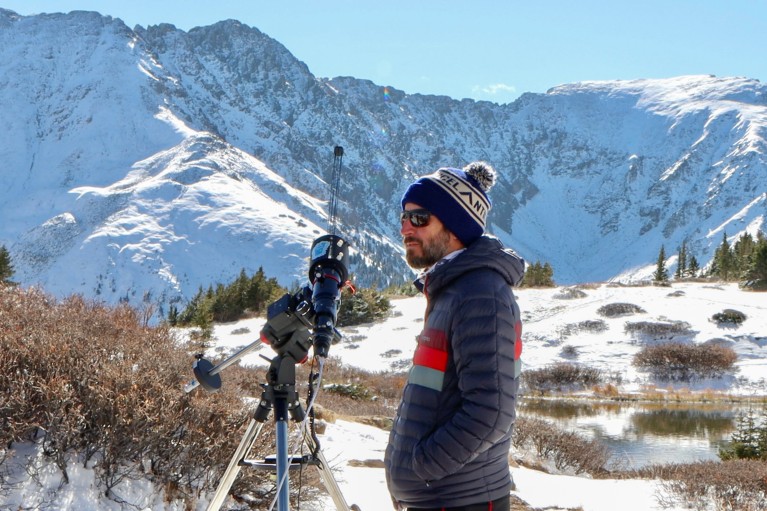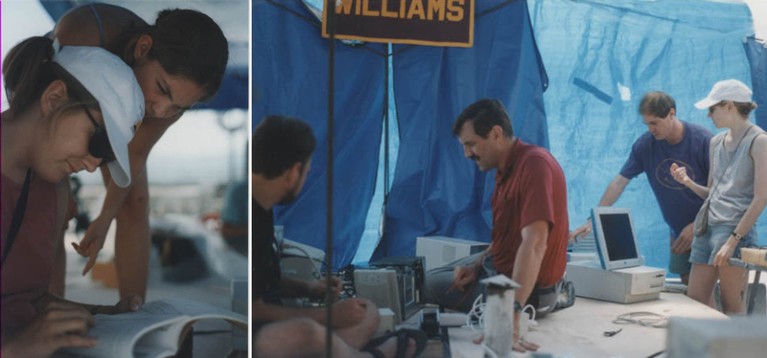
Dan Seaton working on an experiment to observe the solar corona during the annual eclipse of 14 October 2023, on top of Loveland Pass in Colorado.Credit: Daniel Zietlow, NSF NCAR
In the summer of 1999, I was a 19-year-old with an interest in astronomy, but no real idea of what I wanted to do with my life — then I saw my first total solar eclipse. I travelled with a group of other undergraduates and professional researchers to Râmnicu Vâlcea, a small city in southern Romania, as part of a research programme funded partly by the US National Science Foundation (NSF), where I watched the skies grow dark, saw a solar corona light up behind the Moon and listened to the ticking of our equipment tracking the Sun for the 140 seconds of darkness.
My school was part of a consortium of eight small colleges in the northeastern United States — most with only one or two astronomy professors — that had banded together to provide summer research opportunities for their students. Funded originally by the W. M. Keck Foundation, and recently by the NSF, the small initiative, called the Keck Northeast Astronomy Consortium, has supported 350 students such as myself over 35 years.
This experience made me realize that I could actually pursue a career in astronomy research, altering the course of my life fundamentally. After I graduated, the time I gained calibrating and analysing solar observations was enough to land me a job at the Smithsonian Astrophysical Observatory in Cambridge, Massachusetts, supporting the Transition Region and Coronal Explorer mission. This led to me doing a PhD on the processes that convert magnetic energy in the corona to heat and radiation during solar flares.
I now study the dynamics of the corona that produce both explosive flares and comparatively gentle outflows that become solar wind. I led a project using an extreme-ultraviolet solar telescope for the European Space Agency, helped to build the first data products from the US National Oceanic and Atmospheric Administration’s Solar Ultraviolet Imager and have pioneered methods to observe the previously obscure middle corona, where the transition from the magnetically dominated solar atmosphere to the pressure-dominated solar wind and heliosphere begins.
Since 1987, thousands of students across the United States have shared similar experiences to mine, thanks to the NSF’s Research Experiences for Undergraduates (REU) programme. REU provides grants of around US$100,000–155,000 to universities and other institutions to embed students in laboratories and research facilities, giving them an introduction to professional scientific research.
Now, this programme, which costs around $80 million a year, is under threat of being eliminated under the proposed federal budget, as the administration of US President Donald Trump plans sweeping cuts to science funding and major changes in the NSF’s mandate.

Researchers on the 1999 Râmnicu Vâlcea expedition that Dan Seaton partook in.Credit: Williams College Eclipse Expedition 1999
Undergraduate research programmes are powerful incubators for nascent talent, especially for students who might not otherwise get to engage in authentic research at their home university. Many support community-college students with no access to research at all and students from small universities that lack either the resources to provide research or the breadth to match students’ interest. REU students are mentored by professional scientists, who gain as much as the students do. Students bring ingenuity and enthusiasm to the labs and research groups they join, and many go on to become trusted colleagues and close collaborators.
In February 2025, the US administration directed the NSF to begin withholding funding. REU sites across the country have had to cancel this year owing to uncertainty about upcoming funding. Several have had their already granted funding rescinded and have had to inform accepted students that they will need to make other summer plans. In the proposed NSF budget for the 2026 financial year, REU programmes are zeroed out completely.
The United States has been a global leader in science and technology for nearly a century, a position that has fostered great economic and societal benefits. And although the threats to US scientific enterprise across the board are myriad, few single investments pay the dividends that the REU programme does. Although it represents less than 1% of the total NSF budget — which itself is less than 0.15% of total federal spending — it is a proven pathway for developing the scientific talent that powers the United States’ worldwide supremacy in science.


